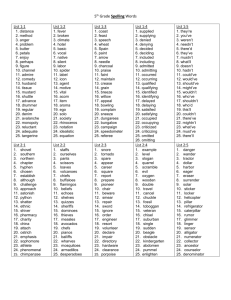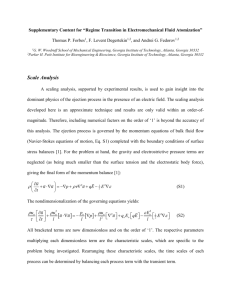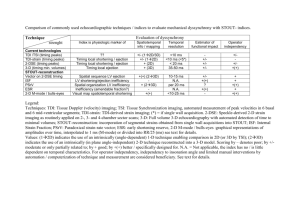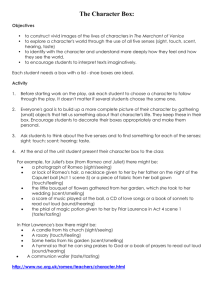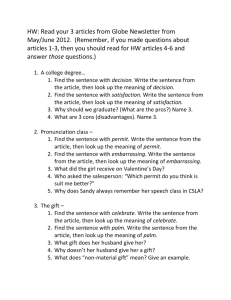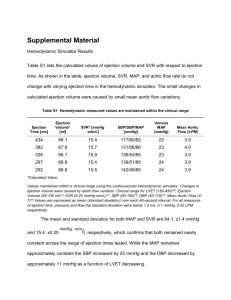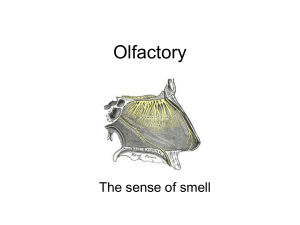Presentation Technique of Scent to Avoid Olfactory Adaptation
advertisement
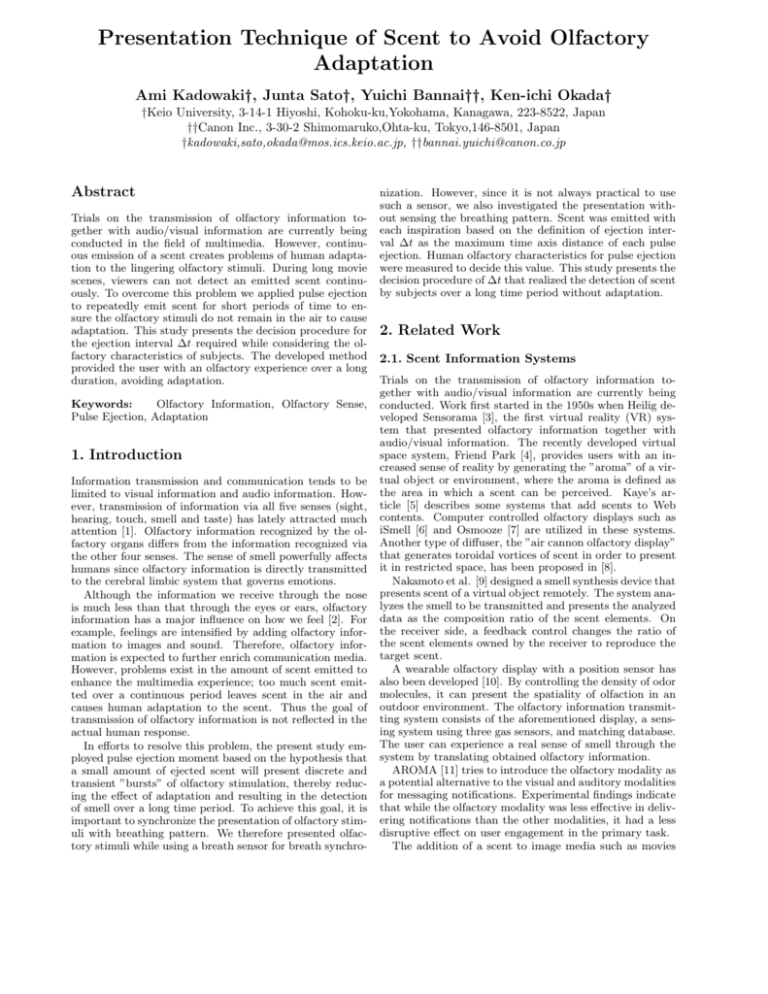
Presentation Technique of Scent to Avoid Olfactory Adaptation Ami Kadowaki†, Junta Sato†, Yuichi Bannai††, Ken-ichi Okada† †Keio University, 3-14-1 Hiyoshi, Kohoku-ku,Yokohama, Kanagawa, 223-8522, Japan ††Canon Inc., 3-30-2 Shimomaruko,Ohta-ku, Tokyo,146-8501, Japan †kadowaki,sato,okada@mos.ics.keio.ac.jp, ††bannai.yuichi@canon.co.jp Abstract Trials on the transmission of olfactory information together with audio/visual information are currently being conducted in the field of multimedia. However, continuous emission of a scent creates problems of human adaptation to the lingering olfactory stimuli. During long movie scenes, viewers can not detect an emitted scent continuously. To overcome this problem we applied pulse ejection to repeatedly emit scent for short periods of time to ensure the olfactory stimuli do not remain in the air to cause adaptation. This study presents the decision procedure for the ejection interval Δt required while considering the olfactory characteristics of subjects. The developed method provided the user with an olfactory experience over a long duration, avoiding adaptation. Keywords: Olfactory Information, Olfactory Sense, Pulse Ejection, Adaptation 1. Introduction Information transmission and communication tends to be limited to visual information and audio information. However, transmission of information via all five senses (sight, hearing, touch, smell and taste) has lately attracted much attention [1]. Olfactory information recognized by the olfactory organs differs from the information recognized via the other four senses. The sense of smell powerfully affects humans since olfactory information is directly transmitted to the cerebral limbic system that governs emotions. Although the information we receive through the nose is much less than that through the eyes or ears, olfactory information has a major influence on how we feel [2]. For example, feelings are intensified by adding olfactory information to images and sound. Therefore, olfactory information is expected to further enrich communication media. However, problems exist in the amount of scent emitted to enhance the multimedia experience; too much scent emitted over a continuous period leaves scent in the air and causes human adaptation to the scent. Thus the goal of transmission of olfactory information is not reflected in the actual human response. In efforts to resolve this problem, the present study employed pulse ejection moment based on the hypothesis that a small amount of ejected scent will present discrete and transient ”bursts” of olfactory stimulation, thereby reducing the effect of adaptation and resulting in the detection of smell over a long time period. To achieve this goal, it is important to synchronize the presentation of olfactory stimuli with breathing pattern. We therefore presented olfactory stimuli while using a breath sensor for breath synchro- nization. However, since it is not always practical to use such a sensor, we also investigated the presentation without sensing the breathing pattern. Scent was emitted with each inspiration based on the definition of ejection interval Δt as the maximum time axis distance of each pulse ejection. Human olfactory characteristics for pulse ejection were measured to decide this value. This study presents the decision procedure of Δt that realized the detection of scent by subjects over a long time period without adaptation. 2. Related Work 2.1. Scent Information Systems Trials on the transmission of olfactory information together with audio/visual information are currently being conducted. Work first started in the 1950s when Heilig developed Sensorama [3], the first virtual reality (VR) system that presented olfactory information together with audio/visual information. The recently developed virtual space system, Friend Park [4], provides users with an increased sense of reality by generating the ”aroma” of a virtual object or environment, where the aroma is defined as the area in which a scent can be perceived. Kaye’s article [5] describes some systems that add scents to Web contents. Computer controlled olfactory displays such as iSmell [6] and Osmooze [7] are utilized in these systems. Another type of diffuser, the ”air cannon olfactory display” that generates toroidal vortices of scent in order to present it in restricted space, has been proposed in [8]. Nakamoto et al. [9] designed a smell synthesis device that presents scent of a virtual object remotely. The system analyzes the smell to be transmitted and presents the analyzed data as the composition ratio of the scent elements. On the receiver side, a feedback control changes the ratio of the scent elements owned by the receiver to reproduce the target scent. A wearable olfactory display with a position sensor has also been developed [10]. By controlling the density of odor molecules, it can present the spatiality of olfaction in an outdoor environment. The olfactory information transmitting system consists of the aforementioned display, a sensing system using three gas sensors, and matching database. The user can experience a real sense of smell through the system by translating obtained olfactory information. AROMA [11] tries to introduce the olfactory modality as a potential alternative to the visual and auditory modalities for messaging notifications. Experimental findings indicate that while the olfactory modality was less effective in delivering notifications than the other modalities, it had a less disruptive effect on user engagement in the primary task. The addition of a scent to image media such as movies has been proposed by a number of researchers. Okada et al. [12] measured the viewer’s mental state by his/her brainwaves, and analyzed the relation between the scent and the viewer’s feelings during a movie. A movie that adds olfactory information to the visual/audio information has been created, but because the synthetic perfume did not accord with the image and the scent was not deodorized, the movie could not be widely distributed. participants who consistently showed the same adaptation pattern, and individual participants did not always show the same adaptation pattern for the same smell. Such variety suggests that there exist factors influencing the recognition of different smells for each participant. • Olfaction and Breathing 2.2. Characteristics of Olfaction • Olfactory Threshold The olfactory threshold is the value used as a standard to express the strength and weakness of a scent. Three kinds of values are generally used for the olfactory threshold: the detection threshold, the recognition threshold, and the differential threshold [13], usually expressed in units of mol (concentration) and mass percentage. The detection threshold is the smallest density at which scent can be detected and where the user does not need to recognize the kind of a smell. The recognition threshold is the smallest density at which the kind of scent can be recognized, and its value reflects the ability of the user to express quality and characteristics of the scent. The differential threshold is the density at which the user can distinguish the strength of a scent, where its value reflects the ability of the user to detect changes in the stimulus and to quantify the change. Generally such changes are expressed as the % change of stimulation quantity of the original. In the case of olfaction, it differs with the different kinds of scent, but is in the range of about 13-33%. When humans breathe in, they inhale smell molecules in the air. When a smell molecule binds to a receptor organ in the nose, we detect a scent. This is the recognition mechanism of a scent [16]. Therefore, it is important that the timing of scent presentation is synchronized with human breathing [17]. In addition, Honma et al. [18] measured a human airintake in a study of telemedicine. Air-intake was found to decrease over time. Figure 1 shows the average airintake during human inspiration. • Adaptation Adaptation is the phenomenon where sensory nerve activity is decreased by continuous smell stimulation. Adaptation itself and the speed of recovery from adaptation differ with the different kinds of scent. Adaptation is gradually strengthened over time but is restored for a short time (3-5 minutes degree) by eliminating the scent. In addition, there are various patterns of adaptation, influenced by the kind of scent and recognition factors. • Measurement of Adaptation At the start of the 20th century, adaptation time was measured by presenting continuous smell stimulation [15]. However, the method was criticized for biasing the participants to smells. In 2003, Saito et al. [14] measured the strength of adaptation directly and found that the subject did not continue to detect the smell when the smell was presented for a long time. When they classified the results of the measurement, adaptation could be divided into several patterns in relation to time dependence. They reported that strength of the smell decreased under the exponential function. When the ratio of each pattern of a participant was observed, the exponential function type was about 30%. For most patterns, subjects could detect a scent again once the strength of smell was reduced. In addition, there were very few Figure 1: Change in air-intake during inspiration over time 3. Presentation Technique of Olfactory Information The conventional olfactory presentation method continues emitting scent at high density for a long time. However, this presentation method creates various problems including, as already mentioned, olfactory adaptation. This means that, for our current purposes of developing a multimedia transmission system for scent as well as visual/audio information, we must overcome this problem. To this end we used pulse ejection of scent to decrease the quantity of scent ejected so as to reduce the scent remaining in the vicinity of the viewer. Pulse ejection is defined as olfactory ejection moment that stimulates the olfactory receptors repeatedly and transiently [19], as shown in Figure 2, in order to reduce adaptation. As already noted, it is important to synchronize scent stimulation with breathing pattern. To ensure satisfactory recognition of scent, we developed a system that synchronizes the emission of scent with the user’s breathing pattern. However, as it is not always practical to use such a breath sensor during scent presentation, in the present can control the quantity of ejection by changing the number of holes used. dt • Olfactory ejection moment Control of ejection is possible for a unit of 100 msec. To ensure there is no delay, ejection continuance time is more than 300 msec and the ejection interval time is more than 100 msec. Time Figure 2: Pulse ejection study we also examined the presentation method over a long period without the use of a breath sensor. Olfactory presentation occurs via pulse ejection for every breath to provide the user with a continuous sense of smell. This requires determination of Δt as the time interval of each pulse ejection. Because the quantity of ejection is reduced, the longest value of Δt is desirable. To decide this value, we must consider carefully the olfactory characteristics of humans in relation to pulse ejection. However, to date, as comparatively little information has emerged concerning such characteristics, we first examined these characteristics. • Wind velocity control: 10 phases The diffuser is equipped with a fan and there are 10 phases of wind velocity control in the range of 0.8 m/sec-1.8 m/sec. • Creating an olfactory scenario The user can create a scenario in which olfactory ejection occurs multiple times and can control the mass of odor ejected by altering the tank number, quantity of ejection, ejection start time and ejection end time. Figure 4 is a photograph showing the use of the olfactory diffuser. The user places the chin on the chin rest, fixing the distance from an olfactory ejection point to the nose at 15 cm. 4. Olfactory Presentation System 4.1. Olfactory Diffuser Figure 3 shows the CANON olfactory diffuser used in the experiment. This diffuser has the following functions. Figure 4: Use of the olfactory diffuser 4.2. Olfactory Ejection with Breathing Synchronization Figure 3: Scent diffuser used • 12 kinds of scent tanks The diffuser has three cassettes, with four scent tanks stored in each cassette, to present the 12 kinds of scent as individual scents or in combination. • Ejection quantity control of 256 phases This diffuser uses an ink-jet method for ejection of scent. Each scent tank has 256 small holes. The user When people inhale, they detect scent molecules. To match the timing of pulse ejection with breathing, we developed an olfactory ejection system that synchronized with breathing. Figure 5 shows a schematic of the system. This system can detect the beginning of inspiration and eject a smell using a timing mechanism. The detector is an NTC thermistor that works by sensing temperature change in air breathed through the nose. Figure 6 shows a representative graph of a thermistor on sensing the user’s breathing pattern. Temperature of a thermistor falls when air flows due to inspiration and expiration, and the output voltage falls. Peaks in the figure 6 indicate inspiration. Measurements taken every 100 ms by the breathing sensor are transmitted to a control computer that is connected to an olfactory diffuser which sends a signal that ejects olfactory Breathing sensor Olfactory diffuser Control computer Figure 5: Olfactory ejection system synchronized with breathing stimili according to the time set. Characteristics such as breathing intervals differ from person to person, and each user must therefore calibrate the breathing sensor before use. 5. Preliminary Experiment 5.1. Continuance Time of Pulse Ejection If more than the required amount of scent is emitted, it remains in the air and can cause adaptation. Therefore it is desirable that continuance time of pulse ejection is the shortest time that an individual can sense it. As the shortest ejection continuance time of the olfactory diffuser is 300 msec and 21 participants were previously found able to sense pulse ejection of 300 msec [20], we assumed a pulse ejection of 300 msec in the present study. 5.2. Detection Threshold The olfactory diffuser allows for control of 256 phases of quantity of ejection, and we defined the smallest ejection quantity of smell that the user can detect as the detection threshold in this study. The experiment to determine the detection threshold was conducted using 300 msec pulse ejections of lavender scent. Olfactory ejection was synchronized with the timing of breathing of each participant. The participants were instructed to respond when they detected a scent. The measurement was increased incrementally to the point where the detection threshold was reached. All 21 participants were able to detect a scent with an ejection quantity of 5 of the 256 phases. We therefore set a detection threshold for 300 msec pulse ejection of lavender with an ejection quantity of 5. For all further experiments, the quantity of ejection emitted was double the detection threshold, i.e. 10 of the 256 phases. 5.3. Adaptation Time When scent was emitted continuously, we measured the time when participants reported adaptation. We defined adaptation time as the time at which the user no longer detected the scent following continuous presentation of the scent at the same density. The participants were presented continuously with a scent of lavender with an ejection quantity of 10. The mean adaptation time of 10 participants was 25 seconds. 6. Experiment 1: Timing and Adaptation to Pulse Ejection In this experiment, we measured the influence of adaptation on olfactory presentation using pulse ejection and olfactory presentation was additionally controlled using a breath sensor for breath synchronization. One pulse ejection occurred for one inspiration. Pulse ejection was performed 15 times (about 2 minutes) and the influence of adaptation was determined. The participants continually depressed the mouse button while perceiving a scent and released it when they no longer detected the scent. The duration for which they detected the scent over the period of 15 pulse ejections was measured. For inspiration, we examined whether sensitivity to a scent differed according to ejection timing. We divided inspiration into three phases: the beginning, middle, and end of inspiration. Scent was emitted at these three different timings, as shown in figure 7. Individual values of duration of inspiration were determined for each participant during calibration of the breath sensor. Twenty participants (18 males, 2 females) participated for a total of three trials at each timing. The fragrance used was lavender. Wind velocity was set at 1.2 m/s. Figure 8 shows a result of Experiment 1. As shown in the bottom right inset, the drop of the line represents inspiration and the rise represents expiration 8. The heavy line indicates emission of scent, and the dotted line the detection of scent by the participant (recorded by depression of the mouse button). As can be seen from the upper left panel figure 8, which is a representative result of the beginning of inspiration, mean inspiration time was 37.6 seconds and mean time to detection of scent was 22.0 seconds. In addition, after the experiment we interviewed the participants to determine whether they perceived a change in density in any of the trials and all 20 responded that they Output voltage (V) -0.8 -1.4 -2 -2.6 0 5 10 15 20 25 Time (sec) point of breathing in point of breathing out Figure 6: Temperature change of a thermistor during breathing Quantity of ejection Ejection one by one The Beginning The Middle Expiration Inspiration The End Time Figure 7: Three timings for pulse ejection did not, indicating that they could detect the scent without adaptation for approximately 2 minutes. The upper right panel is a representative result for the middle phase, and the lower left panel for the end phase of inspiration. Table 1 shows the measurement results at each ejection timing. Participants were not able to detect much of the scent by pulse ejection at the end of inspiration. We could not therefore observe the influence of adaptation at that timing. Total ejection time was 4.5 seconds. The participants were able to detect enough scent from one emission and adaptation did not occur during the approximate two minutes of ejection at the beginning of inspiration until the middle of inspiration. For continuous ejection the participants showed adaptation at an average of 25 seconds. Thus the influence of adaptation could be reduced through pulse ejection. Table 1: Detection of a scent according to timing of inspiration Timing Smell detection time Adaptation Beginning 22.0sec No Middle 12.4sec No End 0.5sec Off the register 7. Experiment 2: Variation of the Detection Threshold The results of Experiment 1 revealed that user could easily detect the scent at the beginning of inspiration but not at the end of inspiration. This suggested that the detection threshold varies with ejection timing. We therefore measured the threshold for each timing, under the assumption that if the detection threshold rises toward the end of inspiration, the user may be able to detect a scent at that time if the ejection quantity is increased. We divided ejection timing into the three phases used in Experiment 1 and measured the detection threshold of 15 participants (14 males, 1 female). Scent was presented using a breath sensor for breath synchronization. Lavender scent was presented by pulse ejection. The ejection quantity rose incrementally until the participant detected a smell. The mean detection threshold at both the beginning and middle of inspiration occurred with an ejection quantity of 5. In addition, the participants were not able to detect a smell even at the highest emission quantity at the end of inspiration. These results indicate that the detection threshold does not vary with an ejection timing in inspiration. 0.1 2.8 5.5 8.2 10.9 13.6 16.3 19 21.7 24.4 27.1 29.8 32.5 35.2 37.9 40.6 43.3 46 48.7 51.4 54.1 56.8 59.5 62.2 64.9 67.6 70.3 107 101 94.6 82 88.3 75.7 63.1 56.8 50.5 44.2 37.9 31.6 19 25.3 6.4 12.7 0.1 69.4 The middle 101 95. 3 89. 7 84. 1 78. 5 72. 9 67.3 61.7 56.1 50.5 44.9 39.3 33.7 28. 1 22. 5 16. 9 5. 7 11. 3 0. 1 The beginning Breathing Emission of Scent Detection of Scent 1 4 7 1013 1619 2225 28 31 34 37 404346 4952 5558 6164 67 70 Expiration The end Inspiration Figure 8: Time at which scent was detected at the 3 ejection timings 8. Experiment 3: Effective Area in Inspi- 9. Deciding the Ejection Interval ration The above experiments enabled us to determine the human Experiment 2 clearly confirmed that a user cannot detect a scent at the end of inspiration. Therefore, it is necessary to examine the range of detection during inspiration to avoid wasteful olfactory ejection. Figure 9 shows how we determined a value to measure this experimentally. The limiting point is the latest time that the user can detect scent in the end phase of inspiration. The effective area is the time range between the start of inspiration and the limiting point. We measured the effective area of 15 participants (14 males, 1 female). Scent was presented using a breath sensor for breath synchronization. Participants responded when they detected a scent for ejection pulses, then the start time of ejection changed incrementally in units of 100 msec. Inspiration length differs among individuals and thus the effective area indicates as a percentage the inspiration length of each user. The inspiration length uses a value taken from calibration of the breathing sensor. The mean limiting point of the participants was 66.7% of inspiration length, with a standard deviation of 3.15, and with small individual differences noted. The effective area therefore ranges from the start of inspiration to 66.7 olfactory characteristics for pulse ejection. Scent was presented using a breath sensor for breath synchronization in these previous experiments. However, as this study thought to avoid the use of breath sensor during a longer period of olfactory presentation, scent was emitted at each inspiration without the use of the breath sensor. The aim of the experiment was to give the user a continuous sense of smell, without adaptation. To achieve this aim we now explain the decision procedure of the pulse ejection interval Δt. The results from Experiments 1, 2 and 3 were as follows. • Scent can be detected without adaptation using pulse ejection • The detection threshold does not vary with ejection timing during inspiration • The effective area is 66.7% of the inspiration length From these results, ejection interval Δt is decided in order to make one ejection in the effective area. Because inspiration length shows individual differences, it is measured before olfactory presentation and the width of the effective area is determined. The decision procedure of ejection interval Δt is shown below. Figure 9: Effective area and limiting point 1. The user breathes normally for 10 cycles of inspiration and expiration. While breathing in, he continually depresses a mouse button visualized on a PC screen. 2. The program calculates the effective area (66.7% of each inspiration) (A) and the remainder (remaining 33.3%, and expiration). These values are stored. Example) Representative data for 5 breathing cycles (100 msec) 15,44,14,41,16,47,12,40,15,45 3. The temporary ejection interval Δt is calculated. the user to continuously detect the scent. In addition, total ejection time was decreased by about 80that we have developed a presentation method that enables users to detect a scent for a long time without adaptation. Table 2: Comparison of 3 ejection methods: Total ejection time (A) and probability emitted in the effective area (B) Ejection method A(sec) B (%) Consecutive 272 100 Pulse(sensing) 15 100 Pulse(interval Δt) 47 98 Δt = average of (A) + 3 (100 msec) ”3” is the continuance time of pulse ejection. Example) Δt = (15 + 14 + 16 + 12 + 15) / 5 + 3 = 17 4. When a scent is emitted in Δt interval, a program judges whether it is emitted entirely in the effective area 10 times. The calculation begins when the user pushes the start button. 10. Conclusion In order to use olfactory information in multimedia, the disparities between its transmission and receipt must be overcome. This requires resolution of the problem of scent remaining in space that results in adaptation. In the study we confirmed that a user could continue detecting a scent Example) Ejection start time in case of Δt = 17 0,17,34,51,68,85,102,119,136,153,170,187,204,221,238, over a long time using pulse ejection. We have presented the decision procedure of the ejection ... interval Δt, a value which was determined based on the study of human olfactory characteristics for pulse ejection. Effective areas on time axes Experiment results revealed an effective area for the detec0-15,59-73,114-130,177-189,229-244 tion of scent using pulse ejection, which ranged from the 5. The case that can emit in all effective areas: Δt = Δt start of inspiration to 66.7% of inspiration length. In addition, the detection threshold in the effective area did not The case that can not: Δt = Δt -1, and return to change. This makes ejection of a certain quantity of scent procedure 4. possible. When scent was ejected in interval Δt, total ejection time was decreased by about 80% compared to the consecutive ejection method and the use of a breath sensor 9.1. Comparison by Various Ejections was not also not required. Our experimental data confirms To verify the ejection interval Δt, we compared the total that the pulse ejection presentation technique allows users ejection quantity of three ejection methods: consecutive to detect scent over a long period without adaptation. We ejection (left panel of figure 10), pulse ejection using the plan to investigate variations of the ejection technique, inbreath sensor (middle panel of figure 10), and pulse ejection cluding changing the scent to correspond with changes in using interval Δt (right panel of figure 10). images and sound. First, the ejection interval was set according to the decision procedure of ejection interval Δt. Then, the program acquired breathing data for 50 breathing cycles for each Acknowledgements participant, and calculated total ejection time and probability emitted in the effective area for each ejection method. This work is supported in part by SCOPE(Strategic Information and Communications R&D Promotion Programme Table 2 shows the mean results for 10 participants. Scent was emitted with a probability of 98% in each effec- ) of MIC(Ministry of Internal Affairs and Communications) tive area of inspiration when ejected in interval Δt, enabling in Japan. Expiration Inspiration Consecutive ejection Expiration Inspiration Expiration Pulse ejection using the breath sensor Inspiration Pulse ejection using interval ⊿t Figure 10: Comparison of 3 ejection methods References [1] Hirose M., Yanagida Y., special topic : Smell and VR (in Japanese), Journal of Virtual Reality Society of Japan Vol.9 No.3 ,2004 [2] Tonoike T., Shibuya T., Aroma Science Series 21 Smell and brain , behavior (in Japanese), Fragrance Journal Ltd. , 2003 [3] Retrofuture: Sensorama’s pre-virtual reality, http://www.retrofuture.com/sensorama.html [12] Okada K. and Aiba S.: Toward the actualization of broadcasting service with smell information, Institute of Image information and Television Engineering of Japan Technical Report (in Japanese), Vol. 27, No. 64, pp. 3134, 2003 [13] A term and a commentary of a odor(in Japanese), Odor Control Association of Japan, 2003 [14] Saito S., Various time dependence of strength of sense for smell showed consecutively(in Japanese), Japan Association on Odor Environment Vol.35 No.1, pp. 17-21, 2004. [4] Shigeno H., Honda S., Osawa T., Nagano Y., Okada K. and Matsushita Y.: A virtual space expressed the scent and wind -A virtual space system ”Friend Park”, Journal of Information Processing Society of Japan (in Japanese), Vol. 42, No. 7, pp. 1922-1932, 2001 [15] H.F. Woodrow and B. Karpman. A new olfactometric technique and some results. [5] Kaye J.: Making scents, Interactions Jan/Feb, pp. 48– 61, 2004 [17] Tonoike T, Recording and analysis of olfactory evoked potentials on the human scalp(in Japanese), Summaries of Reports of the Electrotechnical Laboratory 863, pp.176, 1968. [6] Edge Review: DigiScent Ismell, http://www.edgereview.com/ataglance.cfm?category =Edge&ID=136. [16] Shibuya T, Tonoike T, Aroma Science Series 21 Odor Receptor(in Japanese), Fragrance Journal Ltd., 2002. [18] Honma T. , Wakamatsu H., Telemedicine by the Compact Type of Assist-Respirator with a New Ventilation Pattern(in Japanese), The Japanese Society of Clinical [7] http://www.osmooze.com/osmooze/osmooshop gb.html Physiology Vol.31, No.6, pp.297-304, 2001. [8] Yanagida Y., Noma H., Tetsutani N., and Tomono A.: An unencumbering,localized olfactory display, CHI ’03 Extended abstracts, pp. 988–989, 2003 [19] Tonoike T.,Yamanaka H.,Sobagaki A., Recording of olfactory evoked potentials on the human scalp, The Japanese Journal of Ergonomics 15, pp.251-258, 1979. [9] Nakamoto T., Nakahira Y., Hiramatsu H. and Moriizumi T.: Odor recorder using active odor sensing system, Sensors and Actuators B, 76 465, 2001 [20] Kadowaki A., Ishizawa M., Bannai Y., Okada K., A Measurement of Two-point Threshold in the Sense of Smell during one Breathing, Information and Communication Engineers IEICE Technical Report MVE200656, pp.79-84, 2006 [10] Yokoyama S., Tanikawa T., Hirota K. and Hirose M.: Olfactory field simulation using wearable olfactory display, Tans. of Virtual Reality Society of Japan (in Japanese), Vol. 9, No. 3, pp. 265-274, (2004). http://www.cyber.rcast.utokyo.ac.jp/project/nioi e.html. [11] Bodnar A., Corbett R., Nekrasovski D. : AROMA: Ambient awareness through olfaction in a messaging application, ICMI ’04 Proceedings, pp. 183- 190, 2004
